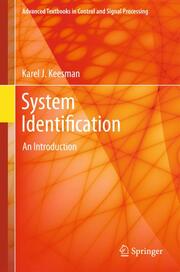Detailansicht
System Identification
An Introduction, Advanced Textbooks in Control and Signal Processing
ISBN/EAN: 9780857295217
Umbreit-Nr.: 1588848
Sprache:
Englisch
Umfang: xxvi, 323 S., 72 s/w Illustr., 37 farbige Illustr.
Format in cm:
Einband:
kartoniertes Buch
Erschienen am 18.05.2011
Auflage: 1/2011
- Zusatztext
- InhaltsangabeIntroduction.- Part I: Data-based Identification.- System Response Methods.- Frequency Response Methods.- Correlation Methods.- Part II: Time-invariant Systems Identification.- Static Systems Identification.- Dynamic Systems Identification.- Part III: Time-varying Systems Identification.- Time-varying Static Systems Identification.- Time-varying Dynamic Systems Identification.- Part IV: Model Validation.- Model Validation Techniques.- Part V: Appendices: Matrix Algebra; Statistics; Laplace, Fourier and z-Transforms; Bode Diagrams; Shift Operator Calculus; Recursive Least-squares Derivation; Dissolved Oxygen Data.
- Kurztext
- System Identification: an Introduction shows the (student) reader how to approach the system identification problem in a systematic fashion. Essentially, system identification is an art of modelling, where appropriate choices have to be made concerning the level of approximation, given prior system's knowledge, noisy data and the final modelling objective. The system identification process is basically divided into three steps: experimental design and data collection; model structure selection and parameter estimation; and model validation, each of which is the subject of one or more parts of the text. The book contains four parts covering:· data-based identification - non-parametric methods for use when prior system knowledge is very limited;· time-invariant identification for systems with constant parameters;· time-varying systems identification, primarily with recursive estimation techniques; and· model validation methods.The book uses essentially semi-physical or grey-box modelling methods although data-based, transfer-function system descriptions are also introduced. The approach is problem-based rather than rigorously mathematical. The use of finite input-output data is demonstrated for frequency- and time-domain identification in static, dynamic, linear, nonlinear, time-invariant and time-varying systems. Simple examples are used to show readers how to perform and emulate the identification steps involved in various model applications, as control, prediction and experimental design, with more complex illustrations derived from real physical, chemical and biological applications being used to demonstrate the practical applicability of the methods described. End-of-chapter exercises (for which a downloadable instructors' Solutions Manual is available from www.springer.com/978-0-85729-521-7) will both help students to assimilate what they have learnt and make the book suitable for self-tuition by practitioners looking to brush up on modern techniques.Graduate and final-year undergraduate students will find this text to be a practical and realistic course in system identification that can be used for assessing the processes of a variety of engineering disciplines. System Identification: an Introduction will help academic instructors teaching control-related courses to give their students a good understanding of identification methods that can be used in the real world without the encumbrance of undue mathematical detail.
